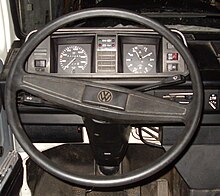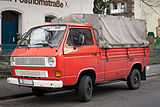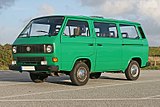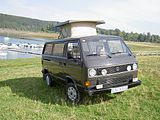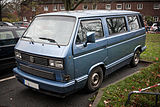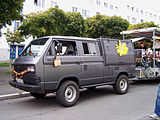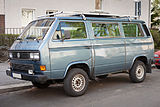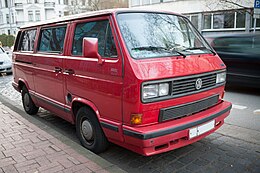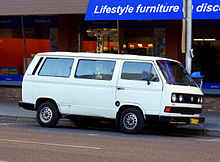VW T3
| Volkswagen | |
|---|---|
|
Volkswagen Type 2 T3
|
|
| Type 2 T3 | |
| Manufacturer: | Volkswagen |
| Sales designation: | Bus, van |
| Production period: | 1979-1992 |
| Previous model: | VW T2 |
| Successor: | VW T4 |
| Technical specifications | |
| Designs: | Minibus , box truck , flatbed truck |
| Engines: |
Otto engines : 1.6–2.1 liters (37–82 kW) Diesel engines : 1.6–1.7 liters (37–51 kW) |
| Length: | 4570-4637 mm |
| Width: | 1844-1870 mm |
| Height: | 1735-2085 mm |
| Wheelbase: | 2455-2480 mm |
| Payload: | 0.61-1.24 t |
| Perm. Total weight: | 2.0-2.7 t |
The VW T3 from Volkswagen was the third generation of the VW transporter . It was produced from 1979 to 1992 and was the last rear-wheel drive van series . After the VW 411/412 from 1968, the T3 was the last newly developed Volkswagen with an air-cooled rear engine . In 1982 the models with gasoline engines were converted from air to water cooling . With a front-engine and front-wheel drive , the completely redesigned successor VW T4 came onto the market in 1990 .
The third generation of VW buses was last named Type 2 . Within this series, the individual models T1 , T2 and T3 were numbered internally. Although these were unofficial names, T3 ultimately prevailed for this model series. It was officially called the Type 2 Model '80 . The construction of the T3 was carried out internally by VW under the designation EA 162 (EA = "development order").
Model history
General
While Volkswagen took over the engine from the Beetle (Type 1) and parts of the chassis from the Kübelwagen (Type 82) for the first Transporter from 1950 (T1) and the T2 from 1967 was only a more developed version with a larger body, the one in May In 1979 T3 presented the first independently developed van model from VW. Apart from the larger, now angular body, it had many technical innovations, such as a rack and pinion steering instead of the roller steering of the predecessor and a front suspension with double triangular wishbones and coil springs instead of the previous crank arm axle with torsion spring bars . The trailing arm rear axle was now also provided with coil springs ( mini block springs ). In the T3, the spare wheel was attached in a hinged device under the front of the vehicle instead of in the interior.
The new T3 was much more spacious; the wheelbase and the car length have been increased by about 60 mm. The T3 was 125 mm wider than its predecessor and 60 kg heavier (1365 kg) even with the smallest engine. Despite this increase in size and weight, the two air-cooled engines were carried over from the predecessor with unchanged performance. The 1.6 l 37 kW (50 hp) engine, like the 2.0 l with 51 kW (70 hp), now had the cooling fan wheel on the crankshaft, so that the engine compartment was 200 mm lower in favor of the trunk. The load compartment floor was lowered to 400 mm above street level, which meant that the interior was 100 mm higher than that of the predecessor (interior height of the panel van: 1465 mm, high-volume panel van: 1880 mm).
Like its predecessors, the T3 is considered robust. Among other things, steel brackets were hidden under the front bumpers, which were connected to one another by parallel beams and thus offered improved impact stability. The corrosion prevention was only satisfactory, however; In the 1989 model year, permanent underbody protection based on wax and bitumen was only available from the factory for an extra 400 DM. The biggest problem of the T3 is joint corrosion, especially on the body side walls, which are made up of several sheets of metal.
Body styles
The following body variants of the transporter were offered from 1979:
- Flatbed truck ( type 245 ) with open loading area and cabin for 2 or 3 people
- Double cabin ( type 247 ) with a shortened loading area and cabin with 2 rows of seats for 5 or 6 people
- Panel van ( type 251 ) with closed body and cabin for 2 or 3 people
- Kombi ( type 253 ) window bus with up to 9 seats in 3 rows with simple interior fittings
- Bus, Bus L ( Type 255 ) window bus as a higher-quality passenger car version with up to 9 seats and upscale interior fittings, with the Bus L also with upscale exterior fittings
With the model year 1984 the names were changed:
- the van became the van,
- from the bus of the Caravelle C,
- from the bus L of the Caravelle CL and
- from the Caravelle (introduced in 1981) by Caravelle GL.
At the same time, the "D" in the abbreviation for the variant with diesel engine was dropped.
As further model variants there were u. a. Ambulances, camping cars ("Westfalia"), fire engines and special equipment for special customers such as B. Deutsche Bundespost and Bundeswehr .
Standard equipment
All type 255 vehicles were equipped with
- Full interior paneling,
- Fresh air nozzles for the rear passenger compartment,
- Chrome-plated hubcaps and bumpers as well as with the Bus L / Caravelle CL also included
- Two-tone paint as standard,
- Upholstery strip on the dashboard,
- Clock,
- Trip odometer,
- Opening windows in the front doors,
- Cigarette lighter,
- Armrests in the front doors.
In autumn 1981 the luxurious Caravelle (later Caravelle GL) based on the Type 255 was added. It was endowed with, among many other things
- Velor seats with armrests,
- Frame headrests front,
- Fabric interior floor and fabric mirror in the side panels,
- Rear wiper,
- H4 headlights,
- special color division of the two-tone paintwork.
In autumn 1983, the crowning glory of the model range was the exclusive six-seater Caravelle Carat , which was mainly designed for business customers. Its equipment included
- Alloy wheels and wide tires,
- Plastic bumpers with front spoiler,
- Comfort chassis with lowered body,
- electrically adjustable exterior mirrors,
- illuminated step on the sliding door,
- Folding table and velor single seats in the passenger compartment (rotatable in the second row of seats),
- Armrests,
- Headrests with padding,
- Reading lamps,
- Cassette radio,
- Side paneling covered with velor and headlining or plastic paneling of the window pillars in the interior.
The trunk / cargo space was not variable, however, as the seats could not be folded down and were difficult to remove. Some of the Carat's equipment details were initially reserved exclusively for this version (e.g. rectangular double headlights, tachometer, fully padded dashboard, power steering and the 1.9i water boxer engine with 66 kW (90 hp)), but were later also available as optional extras for the simpler T3 .
Optional extras
The "classic" additional equipment available from 1979, which was already known from the predecessor T2, included, for example, a large steel sliding roof in the passenger compartment, 3-speed automatic transmission (only for 2.0 l engine), additional heating (also as a parking heater ) , Halogen main headlights (instead of conventional twin-filament lamps - "Bilux"), fog lights, radial tires (instead of diagonal tires ), reversing lights, rear window heating, sliding windows in the passenger compartment, fabric seats (from 1980; initially only for buses and buses L), headrests, interval wipers , Timer, three-stage fresh air blower, brake booster (for 1.6-l engines), brake indicator light or the characteristic two-tone paintwork (only for buses, standard on Bus L). Some of it became part of the standard equipment during the construction period.
In the course of the 1980s, VW continuously expanded its range of additional special equipment. The VW transporter / bus was available with power steering (together with a smaller, padded steering wheel), electric window lifters, electrically operated and heated exterior mirrors, central locking , tachometer, rear window wiper, seat heating , headlight cleaning system and (from the beginning of 1985 in the "syncro" model). ) also available with all-wheel drive . An air conditioning system could also be ordered for models with injection engines for DM 4850 (model 1989), which could be recognized by a cooling air duct mounted in the middle under the roof. From 1987 an anti-lock braking system (ABS) was also offered for the T3 , it cost 3720 DM (1989) surcharge. An airbag was only available in the successor model T4.
Engine variants
As with the T2, the engine was again arranged lengthways in the rear, although this concept was already considered obsolete when the T3 was released because it was still not possible to provide a continuous loading area. At the same time, other manufacturers such as Toyota were pushing their way onto the van market with the Hiace . Accordingly, the third generation of the VW Transporter sold poorly in export from year to year. In Germany, the Netherlands and Austria, however, the T3 always had high sales figures.
When the T3 was launched, there were only two air-cooled boxer engines (gasoline engines) to choose from. Maintenance -free hydraulic valve lifters and a contactless transistor ignition with Hall sensor were new , which made it possible to extend the maintenance intervals from 5000 to 7500 km. From 1981 there was also a significantly more economical 1.6-liter diesel engine, the output of which was reduced to 37 kW (50 hp) compared to the car variant.
As with the T2, there are air inlets for the engine cooling in the side walls at the rear (D-pillars) (until the end of 1980 made of sheet metal in the vehicle color, then provided with finer ribbed, black plastic grille). The passenger compartment was ventilated through the grill between the headlights. The models with diesel engines and those with water-cooled Otto / boxer engines had an additional front grille above the front bumper , behind which the water cooler was hidden. The rear air inlets were then only used to draw in combustion air for the engine.
In the course of the 1980s, VW came up with numerous innovations in terms of engines:
- Diesel engine 1.6 D with 37 kW (50 PS / from January 1981). In 1987, the displacement of the naturally aspirated diesel was expanded to 1.7 liters and the output rose to 42 kW (57 hp).
- Water-cooled 1.9 liter boxer engines ("Wasserboxer", WBX) - (from model year / autumn 1982), initially with 44 and 57 kW carburettor engines (60/78 hp) as a replacement for the air-cooled types with 1.6 liters / 37 kW and 2.0 liters / 51 kW, later also as 61 (KAT) and 66 kW injection engines. The air-cooled boxer engines were offered for export and for government vehicles until the beginning of 1983.
- Turbodiesel 1.6 TD with 51 kW (70 PS / from the end of 1984)
- From 1985: 2.1 liter / 82 kW water boxer (112 PS) without or as a 70 kW variant (95 PS) with catalytic converter , electronic ignition and petrol injection ( Digijet / 82 kW) or ( Digifant / 70 kW).
| model | Displacement | design type | Cyl. | Mixture preparation | kW / PS | MKB 1 | construction time | annotation |
|---|---|---|---|---|---|---|---|---|
| Petrol engines | ||||||||
| 1.6 | 1584 cc | LBX | 4th | Carburetor | 37/50 | CT / CZ | 1979-1982 | |
| 2.0 | 1970 cc | LBX | 4th | 2 carburettors | 51/70 | CU | 1979-1982 | CV, injector Digijet for export |
| 1.9 | 1913 cc | WBX | 4th | Carburetor | 44/60 | DF | 1982-1985 | |
| 1.9 | 1913 cc | WBX | 4th | Register carburetor | 57/78 | DG | 1982-1990 | |
| 1.9 | 1913 cc | WBX | 4th | Register carburetor | 54/73 | SP | 1986-1988 | Kat, for Switzerland |
| 1.9 | 1888 cc | WBX | 4th | Digijet | 61/83 | DH | 1983-1985 | Kat, for USA / Canada |
| 1.9 | 1913 cc | WBX | 4th | Digijet | 66/90 | GW | 1983-1985 | |
| 2.1 | 2109 cc | WBX | 4th | Digijet | 82/112 | DJ | 1984-1989 | |
| 2.1 | 2109 cc | WBX | 4th | Digifant | 70/95 | MV | 1985-1990 | |
| 2.1 | 2109 cc | WBX | 4th | Digifant | 64/87 | SR | 1986-1992 | G-Kat, for Switzerland |
| 2.1 | 2109 cc | WBX | 4th | Digifant | 68/92 | SS | 1989-1992 | |
| 1.8 | 1781 cc | line | 4th | - | 70/95 | AAX | 1995-1999 | for South Africa |
| 2.3 | 2309 cc | line | 5 | - | 90/120 | AFU | 1995-2002 | for South Africa |
| 2.5 | 2480 cc | line | 5 | K-Jetronic | 100/136 | AAY | 1991-1995 | for South Africa |
| 2.6 | 2553 cc | line | 5 | - | 100/136 | ADV | 1997-2002 | for South Africa |
| Diesel engines | ||||||||
| 1.6 D | 1588 cc | line | 4th | Distributor injection pump | 37/50 | CS | 1981-1987 | |
| 1.6 TD | 1588 cc | line | 4th | Distributor injection pump with turbocharger | 51/70 | JX | 1984-1992 | |
| 1.7 D | 1715 cc | line | 4th | Distributor injection pump | 42/57 | KY | 1987-1992 | |
Multivan and camper vans
Non-commercial van owners used their vehicles primarily as family and leisure vehicles. The “Multivan”, which was newly introduced in 1985, set new standards as a versatile large-capacity car. In contrast to the Caravelle (for upscale passenger transport), which has been available for a long time, the focus here was on recreational use with overnight accommodation in the bus. The six-seater car had fabric-covered seats as standard (with armrests at the front), a fabric floor in the front of the driver's compartment, behind the driver's seat a single seat against the direction of travel with a lap belt, in the passenger compartment a folding table with a transistor fluorescent lamp, a three-seater foldable rear bench seat with lap belts and above the engine (in the trunk) a bunk foam overlay (which resulted in an effective lying area of 1.88 × 1.60 m), wooden floor with plastic covering, full paneling of the interior, side walls thermally insulated with Sillan mineral wool, button-in curtains, a second battery and one Absorber cool box with a volume of 36 liters. There were storage spaces under the single seat and the back seat. As a special additional equipment item for a surcharge of DM 4,275 (model year 1989), the Multivan was available with a pop-up roof from Westfalia , which , when opened, offered an additional sleeping space of 1.94 × 1.16 meters. Fewer exterior colors were offered for the Multivan than for the van variants.
The advantage of the "Multivan" compared to the real camping version of the T3 was the significantly lower price. As early as 1979, VW offered significantly more elaborately equipped and therefore more expensive camping vehicles for the T3, which had an interior developed by Westfalia . These buses are commonly referred to as "Westi". In addition, numerous camping vehicle outfitters had conversions and extensions based on the T3 in their program, for example Weinsberg , Dehler Mobilbau ("Dehler Profi"), Reimo as well as Teca and Carthago. Camping extensions from the British company Devon were produced for left-hand drive vehicles under license from the Dutch company Eurec. In contrast to the Westfalia extension, the Devon extension has pop-up roofs that open laterally over the entire length of the vehicle.
The VW camper vans based on a Westfalia facility received the model names
- "Camping" (until autumn 1983)
- "Joker"
- "Club Joker"
- “ California ” was the name of the model version later sold by Volkswagen itself as a slightly slimmed-down Joker variant.
- “Atlantic” was a motorhome version that was upgraded by VW, among other things with exterior mirror housings painted in the vehicle color, plastic insulating windows at the rear and plastic planking all around, which is very much sought after today.
Numerous special models based on the T3 were created for the German market
- 1983 only: Tone-on-tone Caravelle special model for the introduction of the water-cooled boxer engine
- from 1987 Magnum as a special Multivan model
- from 1987 Caravelle Coach based on the Caravelle C (also available in Austria)
- from 1989 Multivan Bluestar (with the badge "Hannover Edition")
- from the end of 1989 Multivan Whitestar (with the badge "Hannover Edition")
The - star models are better equipped than the normal Multivan:
- Power steering with padded steering wheel
- Tachometer, digital clock and trip meter
- central locking system
- electrically adjustable exterior mirrors
- Rectangular twin headlights
- Thermal insulation glazing
- Special exterior colors and own upholstery fabric design inside
- Padded dashboard in light gray
- All-round plastic planking in body color
- lowered body
- Aluminum wheels with wide tires 205/70 R14
Syncro and double cabin models
In 1978, some prototypes of the predecessor model T2 with switchable front-wheel drive were made, which could climb an incline of 77 to 94 percent. The experience gained from this flowed into the development of the T3 with permanent all-wheel drive , which appeared from the end of 1984 as the " Syncro " model and was produced by Steyr Daimler Puch AG in Graz (Austria).
The mountaineering ability of the standard models with rear-wheel drive ranged between 28 and 50 percent; the "syncros" managed a gradient of 54 to 70 percent (with a 16-inch chassis: 3 to 6 percent more, max. 73 percent). Major changes to the chassis and body were necessary for the 4WD variant. For example, the larger 70-liter tank - made of plastic for the first time in the Transporter - was moved to the rear over the transmission , as the cardan shaft to the front axle differential was led through space under the floor. The solution of stowing the spare wheel at the front under the pedal base could only be retained for models with 14-inch wheels. A 16-inch spare wheel was too big and had to be stored upright in the luggage compartment or on a rear rack on the tailgate. The gearbox was supplemented with a fifth, briefly geared crawler gear and an output to the front axle and, like the axle drive at the front, was available with a mechanical differential lock at an additional cost .
Based on the 4 body shapes known from the 2WD model, the variety of models in the T3 " Syncro " increased due to different wheel sizes, which in turn required an unusually diverse range of gear ratios. Based on the standard 185 R14 tires, models with wheels up to 205 R16 or 6.50 R16 (16-inch chassis) were also offered. With the latter, good terrain characteristics could already be determined on the test samples of the T2 all-wheel drive, which were then confirmed in the T3 "Syncro" and there were more limited by the engine than the chassis.
The syncro 16-inch version (additional equipment code M625) had a considerable additional price of approx. 8,000 DM (1989), since this special chassis required extensive measures to strengthen the body, brake system (larger front disc brakes with 280 mm Ø) and various drive elements . The curb weight was 50 kg higher than the syncro with 14-inch wheels. The external identification mark are the modifications to the body to allow the large wheels to move freely. Only 2138 pieces were produced, which is why these vehicles are sought-after collector's items.
A total of 45,478 T3 Syncro were produced.
In Austria, the syncro was initially sold as "allrad" because it was feared that the name "syncro" would not be able to address the market. The emblems on the rear have been changed, and the sales brochure also advertised it as "all-wheel drive". Some vehicles also have the adhesive film “In Österreich invented ” on the rear window . Made in Graz - VW Allrad ” provided.
As the only generation of the transporter to date, the T3 could come up with two special models of the double cab (DoKa):
- "TriStar" as a four-door with Carat headlights, Carat front bumper, heated rear window, plastic wheel arches, carpet, textile-covered seats with armrests, as well as the rear bench, complete interior insulation, black anodized sliding windows at the rear. A few models were delivered to Sweden as "normal" Dokas (without all-wheel drive) .
- "Jagdwagen" as "Syncro" was specially tailored to the needs of foresters and hunters and was only produced in small numbers.
- "Magnum" (DoKa) has nothing to do with the Multivan "Magnum" and was only delivered to Sweden. This model had the rectangular twin headlights of the Caravelle Carat with the headlight cleaning system prescribed in Sweden and fabric-covered seats with heated seats .
Limited Last Edition (LLE)
The T3 was the last vehicle that Volkswagen produced in Europe with the traditional rear-engine drive , which is why it is viewed by many fans as the last "real" Bulli. Demand was correspondingly high towards the end of the production period: after production in the main plant in Hanover-Stöcken had ended in 1990, government vehicles and Syncros were manufactured at Steyr Daimler Puch AG in Austria until 1992 . When the series was finally phased out, VW brought out a new edition of the Multivan as a "Limited Last Edition" (LLE). The LLE was also built in Graz and is basically equipped in the same way as the 1989/90 Blue and Whitestar series. It was available in tornado red and orly blue metallic (dark blue compared to the light blue of the Bluestar) and only as a 51 kW turbo diesel “JX” or a 68 kW water boxer “SS”. Exactly 2500 of these were built; 2499 pieces were sold and are sought-after collector's items today.
The T3 LLE with the number 2500, the very last example built in Europe , is now in the car museum in Wolfsburg .
However, Volkswagen did not expect the LLE to sell rapidly and promised several hundred VW members one of the buses. However, all 2499 numbered copies were quickly sold out, and so at the end of 1992 / beginning of 1993 two completely identically equipped models were released as “Redstar” and “Bluestar”. This was only available as a "JX" turbo diesel. So there are two Bluestars, a light blue Bluestar from 1989/1990 and a dark blue Bluestar from 1992/1993. The 1992/1993 Blue and Redstar were never available in stores, they were only reserved for those employees who had been promised an LLE . The circulation of these last blue and red stars was 500 copies. They did not receive a certificate like the LLE and the chassis numbers are not consecutive either.
Even 18 years after the end of production, numerous examples are still in use as commercial vehicles by companies and authorities. The army took from 1988 the version T3 flatbed as the successor to the T2 flatbed. This type had a wider range of uses and was used for material and passenger transport of all kinds as well as in basic motor vehicle training. Until it was replaced in 1995 by the successor model T4, the Bundeswehr had 4,340 vehicles.
Production sites
From 1979 to 1990 the VW Type 2 T3 was manufactured in the Hanover plant, and from 1984 to 1992 also in Graz, Austria at Steyr Daimler Puch . Until summer 2002, the South African VW plant in Uitenhage continued to build the T3 as a Microbus and Caravelle for the African market.
Production in South Africa until summer 2002
In South Africa, the T3 continued to be built as the Microbus and Caravelle in Uitenhage until summer 2002 and was only sold on the African market. The body has been subtly developed. Larger side windows were installed and the air intakes redesigned. The vehicles were richly equipped and had equipment details that were not offered in Europe. Diesel engines and auxiliary heating, however, were not available. From the end of 1991 the “water boxers” were replaced by four- and five-cylinder in-line engines (1.8i with 70 kW and 2.5i with 100 kW), later exclusively Audi five-cylinder engines (2.3i with 85 kW and 2.6i) with 100 kW) built in with petrol injection. Air conditioning, central locking, immobilizer, etc. can be found in almost every African bus - however, exhaust gas cleaning is not available in all African vehicles, and the vehicles are only produced as right-hand drive. The T3 is still very popular in Africa - similar to the Citi Golf, which was built until 2009, in various versions with up to 74 kW (injection engine without catalytic converter) and modern equipment.
Technical specifications
VW Transporter T3 (1979–1992)
| 1.6 | 2.0 | 1.9 | 1.9 | 2.1 | 2.1 | 1.7 D | 1.6 D | 1.6 TD | |
|---|---|---|---|---|---|---|---|---|---|
| Engine code: | CT / CZ | CU / CV | DF | DG | MV / SS | DJ | KY | CS | JX |
| Construction time: | 1979-82 | 1979-82 | 1982-85 | 1982-90 | 1985-92 | 1984-90 | 1987-92 | 1981-87 | 1984-92 |
| Engine: | 4-cylinder boxer engine, spur gears, central camshaft, tappets , bumpers and rocker arms , hydraulic valve clearance compensation | 4-cylinder in-line engine, overhead camshaft, toothed belt | |||||||
| Cooling: | Air cooling | Water cooling | |||||||
| Displacement: | 1584 cc | 1970 cc | 1913 cc | 2109 cc | 1715 cc | 1588 cc | |||
| Bore × stroke in mm: |
85.5 x 69.0 | 94.0 x 71.0 | 94.0 x 68.9 | 94.0 x 76.0 | 79.5 x 86.4 | 76.5 x 86.4 | |||
| Maximum power (PS) at 1 / min: |
37 kW (50 PS) 4000 |
51 kW (70 hp) 4200 |
44 kW (60 hp) 3700 |
57 kW (78 PS) 4400 |
70 kW (95 hp) 4800 |
82 kW (112 hp) 4800 |
42 kW (57 hp) 4500 |
37 kW (50 hp) 4200 |
51 kW (70 hp) 4500 |
| Max. Torque: at 1 / min |
103 Nm 2400 |
137 Nm 3000 |
140 Nm 2200 |
150 Nm 2600 |
160 Nm 2800 |
174 Nm 2800 |
103 Nm 2800 |
103 Nm 2000 |
138 Nm 2500 |
| Mixture preparation : |
A Fallstromver- carburetor Solex 34 PICT 4 |
Two Fallstromver- carburetor Solex 34 PDSIT-2 / -3 |
A Fallstromver- carburetor Solex 34 PICT 4 |
A downdraft register carburetor Solex 2E3 (2E4) |
Digital injection system (Digifant) | Digital injection system (Digijet) | Distributor injection pump | Distributor injection pump turbocharger |
|
| Gearbox, series: | 4-speed | 5-speed | 4-speed | ||||||
| Gearbox, optional: | - | 3-speed automatic | 5-speed | 5-speed, 3-speed automatic | 3-speed automatic | 5-speed | |||
| Front suspension: |
Double wishbones , progressive coil springs, stabilizer , telescopic shock absorbers with syncro: subframe for front axle drive with viscous coupling |
||||||||
| Rear suspension: | Trailing arm , mini block springs, telescopic shock absorbers | ||||||||
| Brakes: | Front disc brakes, rear drums, brake booster and regulator, optional ABS (from 1986) |
||||||||
| Body: | Self-supporting all-steel body, frame floor system with longitudinal and cross members, front bumper deformation element | ||||||||
| Tank: | Sheet steel, 60 liters; (syncro: plastic, 70 liters) | ||||||||
| Track width front / rear: | 1568/1560 mm | ||||||||
| Wheelbase: | 2460 mm (syncro: 2455 mm, with 16-inch chassis: 2480 mm) | ||||||||
| Wading depth * : | 310 mm (syncro: 350 mm; with 16-inch chassis: 390 mm) | ||||||||
| Turning circle: | 10.7 m (syncro: 10.9 m; with 16-inch chassis: 11.3 m) | ||||||||
| Length: | 4570 mm (box / combi / platform) to 4636 mm (large platform) | ||||||||
| Empty weight 1 : | Panel van / station wagon / flatbed: 1395 kg, high-space station wagon: 1445 kg, large-capacity bed: 1490 kg, double cabin: 1450 kg station wagon L and Caravelle C / CL: 1480 kg, GL: 1510 kg, Carat: 1730 kg additional weights - 42- kW diesel engine: 70 kg, 51 kW diesel engine: 85 kg automatic: 40 kg, for tarpaulin / bow - flatbed: 35 kg / double cab: 25 kg syncro: 145 kg (with 16-inch chassis: 195 kg) |
||||||||
| Payload 2 : | 610 kg (Caravelle Carat) to 995 kg (panel van); aW with reinforced suspension, payload increased by 240 kg | ||||||||
| Top speed 3 : | 110 km / h | 127 km / h | 118 km / h | 130 km / h | 141 km / h | 150 km / h | 115 km / h | 103 km / h | 127 km / h |
| Consumption at 90 km / h 4 in liters / 100 kilometers: |
11.2 N (4-speed) |
11.1 N (4-speed) |
9.7 N | 9.4 N | 9.8 N | 8.8 SP 5 | 8.0 D with 4-speed: 8.5 D. |
- | 7.9 D with 4-speed: 8.3 D. |
| Consumption at 120 km / h liters / 100 kilometers: |
- | - | - | - | 15.1 N 18.4 N 6 |
13.1 SP 15.1 SP 6 |
- | - | - |
| Consumption city 7 liters / 100 kilometers: |
15.7 N (4-speed) |
15.4 N (4-speed) |
11.8 N with 4-speed: 12.9 N |
10.9 N with 4-speed: 13.9 N |
15.5 N | 12.0 VP | 9.8 D with 4-speed: 8.9 D. |
- | 8.7 D with 4-speed: 8.6 D. |
Consumption values according to DIN 70030 (part 1)
* Only for gasoline engines - with turbodiesel: 200 mm (instead of 310 mm); 1 for load-transporting vehicles with a driver, for passenger-transporting vehicles without a driver (1.6 liters: - 30 kg); 2 with automatic 40 kg less, 3 values for panel van, station wagon, Caravelle, Multivan and double cab with rear-wheel drive (syncro: - 5 to 8 km / h)
Platform truck: - 3 km / h, high-volume box / station wagon: - 5 km / h, automatic: - 5 km / h; 4 5-speed gearbox, high-volume box and station wagon: up to 1.5 liters more
5 Super 98 octane (Superplus); 6 high-room combination with automatic; 7 with 5-speed gearbox, 4-speed gearbox: 1.1 to 3 liters more, automatic: 1.0 to 1.8 liters more
literature
- Bernd Wiersch: The VW Bulli: The transporter legend for people and loads . Delius Klasing, Bielefeld 2009, ISBN 978-3-7688-2579-5 .
Web links
- Link catalog on the subject of VW buses at curlie.org (formerly DMOZ )
- Volkswagen Classic Dossier on the T3
- T3 information - valuable tips for T3 drivers
- Interest group VW Bus T3
- Bulli forever - the VW Transporter T3 celebrates its 40th birthday
Individual evidence
- ^ T3 ("Bulli"). Volkswagen Classic, accessed August 24, 2014 .
- ↑ 1.6 / 2.0 liters (1979-1982); Dieter Korp: Now I'm helping myself , Volume 102, VW Transporter and Bus - July '79 to September '82, Motorbuch Verlag, Stuttgart, ISBN 3-87943-933-8
- ↑ Vans and buses, technical data and equipment, print no.815 / 1191.04.00 / 05.00, Volkswagen AG (January 1989)
- ↑ The Volkswagen Transporter - the third generation. (PDF) (No longer available online.) Volkswagen Commercial Vehicles , formerly the original ; accessed on August 24, 2014 . ( Page no longer available , search in web archives ) Info: The link was automatically marked as defective. Please check the link according to the instructions and then remove this notice.


